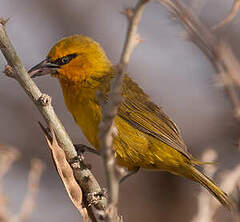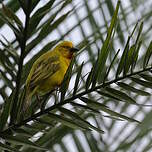Spectacled Weaver
Ploceus ocularis - Tisserin à lunettes
Identification
The Spectacled Weaver is a relatively large weaver. The adult's coloration is mainly yellow, as with most weavers. The sexual dimorphism, however, is weak. The male differs from the female only in the black chin and throat. The species is easily recognized by its golden yellow head with a black lateral band forming a mask, including the eye with the almost white iris. The face is often dominated by a light chestnut hue, more or less pronounced according to the subspecies. The upper parts have an olive-green hue, tinged with yellow, particularly on the edges of the remiges. The overall impression is one of uniformity. The under parts are all yellow. The long, thin beak, with its sharp and slightly curved tip, is black. The legs are gray. The juvenile is similar to the female, but the crown is tinged with olive, the beak pale yellow, the eye-band barely visible, olivaceous, and the iris much less pale. The beak turns brown at the age of 3 months.
Subspecific information 3 subspecies
- Ploceus ocularis ocularis (extreme s Mozambique and ne, e South Africa)
- Ploceus ocularis crocatus (se Nigeria and Cameroon to sw Ethiopia, w Kenya, nw Tanzania, Angola, n Namibia and nw Botswana)
- Ploceus ocularis suahelicus (e Kenya to Mozambique)
Foreign names
- Tisserin à lunettes,
- Tejedor de anteojos,
- tecelão-de-lunetas,
- Brillenweber,
- pápaszemes szövőmadár,
- Brilwever,
- Tessitore dagli occhiali,
- glasögonvävare,
- Brillevever,
- pletiarka okuliarnatá,
- snovač brýlový,
- Brillevæver,
- vaaleasilmäkutoja,
- Brilwewer,
- teixidor d'antifaç,
- wikłacz okularowy,
- Очковый ткач,
- メグロハタオリ,
- 眼斑织雀,
- glasögonvävare,
- 眼斑織布鳥,
Voice song and call
The contact call is a chek or chak, tchek or tchak, quite sharp. During food-seeking phases, phrases made up of quickly repeated, slightly descending notes can be heard, tu tu tu tu tu tu tu... or ki ki ki ki ki ki ki..., to stay in contact. This call evokes a distant curlew cry or a Merlin cry. Single tiou calls can also be heard. The song is a short, complex phrase with a ringing sound that is for the female at the nest and when reunited after a short separation: chiririou kakachwirrwirrwirra. It often includes the iterative call mentioned earlier. The Spectacled Weaver's call is often referred to as the chiririou kakachwirrwirrwirra call.
Habitat
Throughout most of Sub-Saharan Africa, the Spectacled Weaver lives in forests with dense undergrowth and their edges, along rivers if it can be sheltered in thorny bushes, in gardens and in valley bottoms. It generally prefers forested habitats but avoids both wet forests and arid regions. It can be found up to 2,000 meters of altitude on the Nyika Plateau in northern Malawi and in northeastern Zambia, up to 2,200 meters in East Africa and rarely below 900 meters in Ethiopia.
Behaviour character trait
The Spectacled Weaver is territorial and monogamous, unlike many polygynous colonial Weavers. The bond between the couple is strong and lasts for multiple breeding seasons, possibly for life.
The male sings for the female throughout the year. The species scavenges for food on the ground and can easily join other groups of insectivorous and frugivorous species which helps it with its search. It hunts for insects while they are flying or more easily in the foliage of trees or even under the bark which it can raise with its strong beak.Dietfeeding habits
The Spectacled Weaver is omnivorous. Its diet mainly consists of insects (crickets, caterpillars, beetle larvae) and is enriched with fruits, berries, seeds and nectar.
It collects nectar from aloes (Aloe marlothii and Aloe ferox), trumpet creepers (Tecoma capensis), flowering leguminous trees (Schotia brachypetala) and the Coral Tree (Erythrina latissima). To a lesser degree, it also collects spiders, millipedes, termites, small crabs and small geckos. Finally, it does not refuse the small pieces of meat and pieces of bread that can be offered to it in lodges.Reproduction nesting
The breeding season runs from September to March with a peak of activity between October and February depending on the distribution area. The pair nests alone and not in a colony like most Spectacled Weavers. United for several seasons, sometimes for life, the couple can come back and nest on the same site as the previous season. Even though the female can exceptionally take part in the nest construction, it is the male's task to build up the lengthy and meticulous construction. For two to three weeks, the male continues to go back and forth from a suitable site to obtain material.
He gets thin vegetable strips which he weaves with his long and pointy beak. The nest is an oval and drooping ball, knotted on a thin branch or avine at the top. Most of the time, the attachment is to a bougainvillea branch, a papyrus or reeds stem (as indicated in the Okavango Delta of Botswana) or even elephant-grass (Miscanthus) at a height of between 1 and 7 meters from the ground, usually at 4 to 5 meters. Any close-by leaves are removed by the adults and only the attachment leaves are kept. The nest has a tunnel directed towards the ground, especially long compared to other Spectacled Weaver nests. It usually measures 10 to 20 cm long but can sometimes reach 60 cm. The female only lays eggs when the inner chambers of the nest are doubled. The eggs are white or light-green, with grayish-brown or reddish-brown spots.Both parents take turns incubating the eggs for 13 to 14 days and both contribute to feeding the young for 15 to 19 days. After each feeding by one of the adults, this adult takes a fecal sac with it.Once older, younglings defecate directly into the entrance tunnel. The young ones are independent two weeks after they fledge. The observation of the nest is optimal in the Spectacled Weaver; the clutch is never left alone. The couple can produce two clutches per year and build a new nest for the occasion. The old nests are not abandoned, even from one year to the next. They are usually reoccupied by the Collared Drongo, the Black-tailed Glossy Starling or the Shiny-plumaged Firefinch. The species can be parasitized by the Greater Cuckoo.Geographic range
The range of the Spectacled Weaver extends south of an Ivory Coast-Ethiopia line and extends to all countries. This range is fragmented due to the species' ecological requirements. It is present year-round. There is great variability between inhabited regions. Three large zones are well occupied: Ethiopia in the north, northeastern DRC, Uganda, and south-western Kenya in the centre. Lastly, there is one in the south in Zimbabwe, Zambia, Malawi, and Mozambique. The numerical variability is also great. In the south, for example, Swaziland hosts more than 20,000 individuals, while the centre and south of Mozambique host more than 100,000 individuals, and there are fewer than 4000 individuals in Kruger National Park in South Africa.
Threats - protection
IUCN conservation status
concern
in the Wild
threatened
evaluated
The species is generally not threatened. Its ability to adapt and live in anthropized environments is a major asset. The longevity of individuals is also favourable for the good conservation of the species; a female was re-sighted at a ringing site after more than 10 years.
Sources of information
- IOC World Bird List (v15.1), Gill, F and D Donsker (Eds). 2025-12-07.
- Birds of East Africa: Kenya, Tanzania, Uganda, Rwanda, Burundi, Terry Stevenson, John Fanshawe
- HBW Alive,
- Biodiversity explorer The web of life in Southern Africa,
- xeno-canto, Sharing bird sounds from around the world,
Other sources of interest
 Specification sheet created on
20/07/2023 by Nathalie Santa Maria
Specification sheet created on
20/07/2023 by Nathalie Santa MariaTranslation by AI Oiseaux.net
© 1996-2025 Oiseaux.net
- Accipitriformes
- Aegotheliformes
- Anseriformes
- Apodiformes
- Apterygiformes
- Bucerotiformes
- Caprimulgiformes
- Cariamiformes
- Casuariiformes
- Charadriiformes
- Ciconiiformes
- Coliiformes
- Columbiformes
- Coraciiformes
- Cuculiformes
- Eurypygiformes
- Falconiformes
- Galliformes
- Gaviiformes
- Gruiformes
- Leptosomiformes
- Mesitornithiformes
- Musophagiformes
- Nyctibiiformes
- Opisthocomiformes
- Otidiformes
- Passeriformes
- Pelecaniformes
- Phaethontiformes
- Phoenicopteriformes
- Piciformes
- Podargiformes
- Podicipediformes
- Procellariiformes
- Psittaciformes
- Pterocliformes
- Rheiformes
- Sphenisciformes
- Steatornithiformes
- Strigiformes
- Struthioniformes
- Suliformes
- Tinamiformes
- Trogoniformes


































